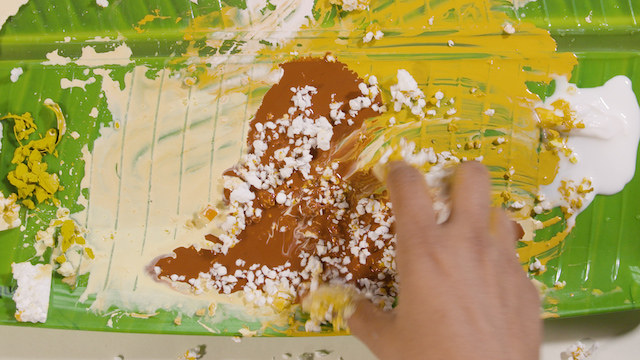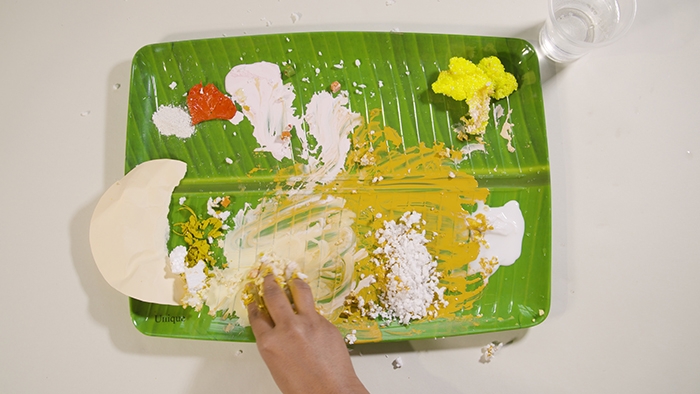Deepa Bhasthi lays out the unwritten rules surrounding formal Indian dining that keep social structures firmly in place
London-based artist Vasundhara Sellamuthu’s video performance Name on Rice (2019) brings to life the haptic and textural experience of eating a traditionally conducted South Indian meal on a banana leaf. By the end of the work, the carefully controlled divisions between the various foodstuffs laid out at the beginning of the meal have been wiped out. What remains is a smudged map of colours, a country without borders.
While this seems to testify to a rather casual approach to dining, in instances such as this, food is never just ‘food’: the multiple processes that make up the experience of eating a banana-leaf meal are the product of mores, unwritten rules and cultural codes. And these determine the making, serving, eating and getting up and leaving at the end of the meal.
Moreover, the ‘food maps’ – evidence of what dishes were served, how they were served, where they were put on the leaf, how a person mixed the rice with the curries, what was eaten first and so on – that one finds on used banana leaves function as caste markers. Those steeped in these codes of eating can detect someone’s caste and subcaste just by observing the way diners navigated a meal. That’s because food maps adhere to codes dictated by the caste of the host. At most formal functions, invitees are near exclusively from the same caste, which makes setting these rules and following them both habitual and easy. When food is served with all these set rules, taught and enforced from childhood with the same discipline reserved for a prayer ritual, there is little room for individual agency and choice in the consumption of the meal.
A banana leaf is sliced across the midrib into three pieces, and the lower part is laid down with the tapering end facing the lefthand side of the person who will sit in front of it. There are designated places for each component of the meal: on the upper half of the leaf, salt is placed on the left corner, a pickle next to it, followed by a range of dry vegetable dishes. On the left side goes the papad, placed across the midrib, while rice is served in the middle of the lower half. A dab of payasa, a sweet pudding, is served on the lower right to start the meal. Upon this basic layout, the rest of the meal is built. The curries are always served by an assembly line of men and a few women – extended members of the family usually, but increasingly hired staff from a catering company these days – in a fixed order. Depending upon the community, the caste and especially the subcaste, both the particular dishes and the order in which they are to be served will vary. In mine, the rasam (a kind of thin soup) would be followed by a thicker gravy and a curd-based curry; the desserts would come somewhere in the middle; and, finally, the quintessentially South Indian curd rice would close the meal. Any change in the order of serving is frowned upon and seen as an affront to the guests; should any such thing occur, the hosts will likely carry that stigma for years to come. Entertainment comes suddenly, and inexplicably, during the middle of the meal, when, for example, a young girl learning classical music or an older gentleman well versed in the songs of Yakshagana (a traditional form of theatre) will be encouraged to sing a song or two. They stop eating to do so, offering up their skill for appreciation and criticism.
While the banana leaf seems to testify to a rather casual approach to dining, in instances such as this, food is never just ‘food’
It’s perhaps not surprising, then, that Sellamuthu uses the multiple dishes on the banana leaf, and the numerous combinations and permutations that should be possible when it comes to their consumption, to speculate on the scope for choice and agency in relation to the meal. The food items in her performance are made of pigments, and while these simulacra are used to draw the multiplicity of textures – the liquids, powders and various solids – that make up a formal meal, they also, the artist suggests, indicate how fragile the codification of banana-leaf dining has come to be.
While the practice of eating lunch and/or dinner off a banana leaf is fairly common in several parts of India, it is in the southern states that the practice is most prevalent. Urban households have long switched to plates for everyday use, but special occasions such as weddings, funerals and other events that are obliged to have a formal setting continue to serve meals on a banana leaf. It is both a nod to tradition and a way to keep costs low – hiring the several dozens of plates required and the labour to clean them afterward is considerably more expensive than buying use-and-throw banana leaves. And in rural households a banana leaf can fulfil an environmentally friendly purpose as well.
One absolutely may not begin eating until every bit of the dry items are served. Then there is a way in which each item must be eaten – some you slurp loudly, some not. A skill cultivated from childhood is how to divide the rice in a way that one could taste all the dishes, finish whatever is on the leaf, ask for seconds of a favourite dish and yet leave the meal full and satisfied – a task that needs much calculation on the part of the diner in portion control. How one mixes the rice with the curry matters too: you may use only up to the middle of your fingers: your palm must be dry to show that you are not savage. Navigating through the rasam’s runny consistency to ensure it stays within the borders of the leaf is an acquired skill.
Before getting up, there is the crucial last step of dealing with the remains. In my community, we bring whatever is left – salt unused in the curd rice, a vegetable found too spicy, garnish of a curry leaf and such – to the centre of the leaf and leave it there. A burp to announce a full belly. In other communities, people fold the leaf in half – folding it towards yourself marks a happiness with the food, a ‘we’ll come again’, whereas folding it away, usually done so at funeral meals, signifies the end of the relationship with the deceased.
The present structure of the banana-leaf meal likely evolved from a combination of culinary aesthetics and ergonomics. As Sellamuthu tells me, the rice zone is where one spends the most time, so it makes sense to have it in the middle. “[On the leaf] you notice the portion sizes gradually getting smaller when you go to the left. You want less salt in your diet, so you put it as far away as you can and you have to stretch and reach for it,” she says, giving examples to explain why the layouts might have evolved the way they did.
The intricate rules governing how a formal meal is conducted might seem like a quirk of various communities, evolved over generations of meals for both practical and obscure reasons. But in truth, they are a cover for the violence of caste and class that is ingrained into the Indian psyche. The various food maps that are drawn in communities may make for colourful pictures and hearty meals, but how the borders between food items are drawn can make a huge difference in a public gathering, often with sinister results.

Where food in general, and communal meals in particular, are supposed to represent the universal binding of people who are different in their beliefs and practices, these ele-oota or ellai saapad serve to sharpen those very differences. The others – those lower down in the social order or those from castes different from that of the host – are served in a separate section of the room, or after the guests belonging to the host’s community have eaten, ostensibly to maintain the sanctity of the eating ritual. Many modern, mixed-caste meals incorporate a buffet section, a codeless meal available to those from castes other than that of the host, that further controls who eats in what ways. Unsurprisingly, nowhere are these rules stricter than among the upper castes, whose sophistication, cleanliness and ritual purity must be maintained at all costs – ideas that have led to nothing good historically. This violence of othering, during the seemingly benevolent act of inviting them to the meal, is a contradiction that is regularly perpetuated.
While dishes from northern parts of India, like a piece of parantha or a sweetmeat alien to southern India, are served as a mark of inclusivity and a cautious willingness to stray from tradition, meat is never served on a banana leaf. Increasingly, even in communities that do eat meat, these dishes are not served in community meals. In a political atmosphere where being vegetarian is today equated with being both a true Hindu and being of a higher social order, these deliberate modifications in community eating experiences are a shameful attempt at homogenising a nation’s diet, one meal at a time. In India, with a rightwing government in power and a majority support for its policies, such food politics have acquired a gravitas and a sense of urgency that is, frankly, frightening.
Deepa Bhasthi is a writer based in Bengaluru
From the Spring 2020 issue of ArtReview Asia
